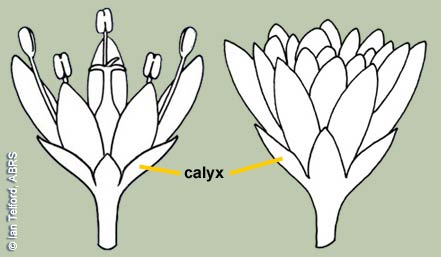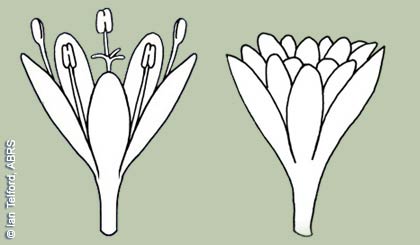| Home | Start key | Fact sheets | Glossary | Common flowers | ||
This feature concerns the presence of a distinct calyx and corolla, or of perianth whorls that are not resolvable as calyx and corolla, on an individual flower.
Flowers that are not resolvable into distinct calyx and corolla whorls are said in this key to have perianth parts, perianth segments, or a perianth whorl or whorls, or, as occurs in the monocots, two similar-looking whorls that are called tepals. The terms calyx and corolla are used here only if the calyx is resolvable (except for the Asteraceae; see below).
Cut flower cultivars that are doubles may have more than the normal number, or extra whorls, of petals, tepals, perianth segments and in some cases, petaloid sepals.
In examining flowers, sometimes it is easy to discern calyx and corolla whorls. Sometimes, however, two whorls are actually calyx and corolla but aren't obviously so. Likewise, two whorls may look like calyx and corolla but are not. If you are not sure which state to choose, ignore this character or use it, keeping in mind that you guessed, and change your state choice if necessary.
Note: in the Asteraceae, there is no true calyx, but sometimes a modified calyx whorl called a pappus is present. The single floret whorl is called a corolla, regardless if there is a pappus or not.
 |
| with a distinct calyx and corolla, or a calyx very dissimilar from other whorl(s) A calyx whorl most often differs from the corolla in shape, size, or color. The right-hand illustration shows that there may be extra corolla whorls in some double flowers, yet these may still have a resolvable calyx. Occasionally, a petaloid calyx may be larger than and enclose the corolla. If such flowers are double, they may have two or more calyx whorls or extra sepals. |
 |
| not resolvable into calyx and corolla (e.g. with one whorl only, or with all perianth parts (in 2 or more whorls or spiralled) similar) If there is no recognizable calyx, there may be one perianth whorl of similar-looking segments. In the Liliaceae and other monocots, often the non-double normal flower has a perianth of two similar whorls. Also, the right-hand illustration shows that there may be extra perianth segments or tepals or whorls in some double flowers. |
 |
| perianth vestigial or absent Flowers lacking a perianth are usually small, and may consist only of a pistil and/or stamens. A vestigial perianth may be small scales, filaments or knobs. |